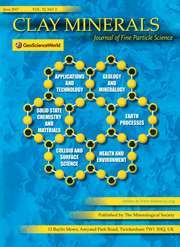Article contents
The consequences for differential thermal analysis of assuming a reaction to be first-order
Published online by Cambridge University Press: 14 March 2018
Abstract
From their isothermal experiments, Murray and White drew the conclusion that the dehydration reactions of clays are first-order with a rate factor of Arrhenius form. The object of this paper is to discuss whether differential thermal analysis can be used to confirm or refute this hypothesis. The problem, previously considered by Murray and White, of a sample heated at a constant rate throughout is recalled. Particular attention is drawn to the effect of heating rate on the temperature at which the maximum rate of reaction occurs.
To apply to differential thermal analysis, the treatment must be extended to take account of thermal gradients; as the mathematics involved is cumbersome, only results are considered. The most important result concerns the effects of sample size and dilution on the position of the turning-point. A disagreement with the results of experiments on kaolinite is pointed out; it is argued that only a small part of this disagreement is due to simplifications made in developing the theory, and it is concluded that the hypothesis that the clay reactions are first-order, with a rate factor of Arrhenius form, is only approximate.
- Type
- Research Article
- Information
- Copyright
- Copyright © The Mineralogical Society of Great Britain and Ireland 1955
References
- 17
- Cited by


